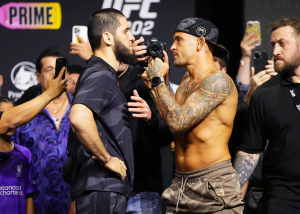The New Guard: Italo Moura
The New Guard: Italo Moura
A Look At One of Brazil’s Best Next-Gen Competitors
(Moura stuffs the head of Celso Ricardo at the 2022 Atlanta Open)
Atos, New Wave, B-Team, Marcelo Garcia, Unity, AOJ, and many more. These are some of the most prominent names in grappling, producing some of the highest level competitors in the last number of years, and presumably, into the not-so-distant future as well. Amongst them, Unity and Cicero Costha product Italo Moura is distinctly notable for reasons unlike the rest. While much has been made of AOJ’s Tainan Dalpra or Atos’s Andy Murasaki, Moura is remarkable not for the attention he’s garnered on the international competition scene, but for the almost complete lack of it.
Despite winning multiple IBJJF Gi and No-Gi titles, as well as a plethora of colored belt World’s and Pan’s Championships, and competing against the likes of the aforementioned Dalpra, Murasaki, and stand-out competitors such as Keenan Cornelius, PJ Barch, Adam Wardzinski, Dante Leon, and Tommy Langaker, Brazil’s Moura still flies largely under the radar. With such an accomplished competitive career in just about 10 years of competing (at only 26 years of age), Moura is likely to be one of the few grapplers leading the charge of “The Next Generation” in the coming years.
Having only been promoted to black belt by Murilo Santana and Cicero Costha in 2019, Moura hasn’t had a tremendous amount of time to firmly establish himself amongst the elite of the elite, but that is likely to change in the near future, should the Brazilian export establish a footing under the continued tutelage of New York’s Santana and Brazil’s Costha. In this article, I will briefly analyze Moura’s game and attempt to bring some well-deserved attention to a wholly underrated and underappreciated competitor.
(Moura’s guard dilemma against Tainan Dalpra, IBJJF 2021 Pan’s)
- The Guard
Italo Moura, similarly to Levi Jones-Leary and Mikey Musumeci, fashions himself as a berimbolo enthusiast. While berimbolo’s are cool and make for great social media content, Moura is acutely aware of the difficulty in successfully incorporating them into a systematic and well-rounded game. Much like the aforementioned grapplers, Moura has managed to apply the threat of the berimbolo into an efficient and crafty guard game. Against Tainan Dalpra, one of the most prolific passing machines in modern grappling, Moura found great success, in a losing effort, implementing fundamental guard techniques off of this dilemma.
Against Dalpra, Moura was essentially faced with a constant passing threat, and in efforts to combat this, was actively switching between De La Riva, Reverse De La Riva, Butterflies, and Crab Rides en route to attempts at the back and 50/50 leg entanglements. While these efforts might seem fruitless against a smash-pass heavy Dalpra, the fundamental concept of off-balancing was ever present as a foundational cornerstone of his approach. Omnipresent off all these different guard retention maneuvers, however, is the threat of the berimbolo. While I don’t believe that the brunt of Moura’s game is built around the berimbolo, I do believe its status as a potentially high scoring maneuver can make it an incredibly threatening weapon in the arsenal of a skilled practitioner. In possessing such a powerful threat, countless other avenues in a grappler’s game are made available. This approach seems to lend itself towards Moura’s guard game. By being active and offensive, and rarely settling for positions, Moura is able to leverage the multifold threats of his guard game into various methods of negating offense and/or supplementing his own.
(Moura working to knee slice through the guard of Alan Sanchez, 2022 No-Gi World’s)
- Passing
While not much of a wrestler, Moura’s passing game is built off what he calls “the dots principle”. This principle is, if nothing else, high level fundamental jiujitsu. This approach conceptualizes the opponent’s guard as having three main “dots”: either shoulder and the hips. In practice, one has to control any combination of these dots to effectively pass an opponent’s guard, and in order to effectively pin an opponent, they must combine all three. For example, in the knee slice pass one has to underhook the far arm, try and catch the near one, and staple the near leg in order to pass; in doing so, he has eliminated at least two dots (underhook, hips), with invaluable control captured with control over all three. While Moura isn’t reinventing the wheel by any means, his systematic and fundamental approach to passing is one which is applicable to virtually any scenario and any position. Notably, the commitment to conceptual grappling is paramount to achieving a high level game, and serves as an important function of Moura’s approach to jiujitsu as a whole.
At 2022’s Atlanta Fall Open, Moura showcased a tremendous ability to blend his varied and diverse guard game with his technical fundamental passing. Throughout the tournament, Moura found great success sweeping and coming up into leg drag positions from where he could seamlessly integrate his tripod and pressure passing. The foundational basis for Moura’s success is high level conceptual grappling; a commitment to fundamentals incorporated at the sport’s highest levels. While he’s yet to win a major black belt world title, Moura’s skills are undeniable and his development of high level fundamental principles bodes well for a future of high level competition. It is for this combination of fundamental skills that this writer believes Moura not only has an incredibly bright future as a world class black belt competitor, but also why I believe he has the potential to be one of the leading forces of next-gen grappling.



